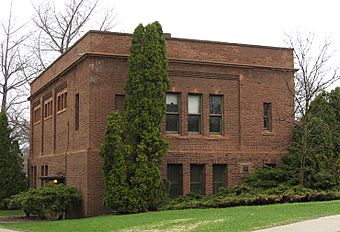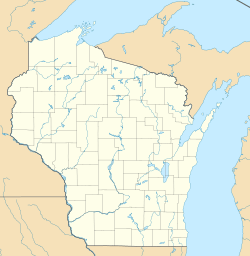Thomas A. Greene Memorial Museum facts for kids
|
Thomas A. Greene Memorial Museum
|
|
|
U.S. Historic district
Contributing property |
|
 |
|
| Location | 3367 N. Downer Ave., Milwaukee, Wisconsin |
|---|---|
| Built | 1913 |
| Architect | Alexander C. Eschweiler, Sr. |
| Architectural style | Moderne, Art Deco |
| Part of | Milwaukee-Downer "Quad" (ID74000106) |
| NRHP reference No. | 93001615 |
Quick facts for kids Significant dates |
|
| Added to NRHP | November 4, 1993 |
| Designated NHL | November 4, 1993 |
| Designated CP | January 17, 1974 |
The Thomas A. Greene Memorial Museum is a special place in Milwaukee, Wisconsin. It is also known as the Greene Geological Museum or Greene Museum. This museum is home to amazing collections of minerals and fossils. It is managed by the University of Wisconsin–Milwaukee's Geosciences Department.
Contents
The Museum Building's History
The original museum building was designed to be fireproof. A famous Milwaukee architect, Alexander Eschweiler, created its plans. This building was made to hold the collection of Thomas A. Greene. He was a druggist in Milwaukee. Mr. Greene was also an amateur geologist, meaning he studied rocks and Earth. He loved collecting plants and fossils too.
In 1913, Mr. Greene's family, Mrs. H.A.J. Upham and Mr. Howard Greene, had the building constructed. They wanted a safe place for his large collection. In 1993, the building was named a National Historic Landmark. This honor recognized how important Mr. Greene's collection was. It was a rare example of a complete amateur geological collection.
Today, the collection is no longer in this original building. It is now displayed and kept in Lapham Hall. This hall is also on the University of Wisconsin–Milwaukee campus. The old museum building has been updated. It is now used for academic classes. It houses UWM's Sam and Helen Stahl Center for Jewish Studies.
What's in the Collection?
Thomas A. Greene gathered most of his fossils in the 1880s and 1890s. His collection grew to about 75,000 specimens. Most of these fossils came from rocks in southeastern Wisconsin. These rocks are called the Silurian Racine Dolomite Formation and the Devonian Milwaukee Formation.
Fossils from Ancient Seas
Many fossils are preserved as molds in dolomite rock. They show a wide variety of ancient sea creatures. These include trilobites, crinoids, and different types of coral. There are also brachiopods, cephalopods, and gastropods. These are all types of marine invertebrates.
Devonian fossils in the collection are mostly fish and plant remains. All these fossils were found in quarries that no longer exist. This makes Mr. Greene's collection very special and impossible to replace.
Amazing Minerals and Meteorites
The museum's mineral collection is also very diverse. It has many different minerals and ores. These come from places all over North America and other countries. You can see beautiful examples of amethyst, apatite, and copper. There are also tourmaline, garnet, and turquoise.
One of the most exciting parts is a piece of iron meteorite. This meteorite landed in Washington County, Wisconsin, nearby. A scientist named Increase A. Lapham gave it to Mr. Greene. Lapham Hall, where the collection is now, is named after him.
Thomas Greene also worked with another amateur collector, Dr. Fisk Holbrook Day. Dr. Day's home in Wauwatosa, Wisconsin is also a National Historic Landmark.
See also



